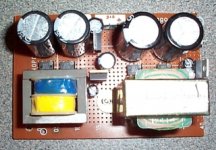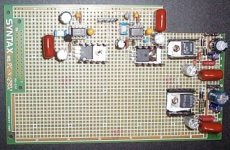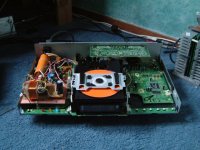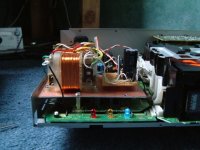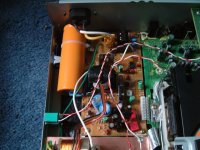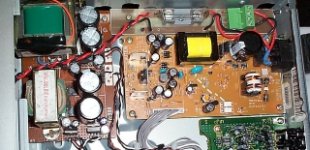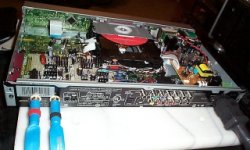David,
In reply to your question regarding the decision to use the same dac chip on a new board, here are some reasons:
-flexibility-- I might want to double up on the dacs and run them in mono in the future as on pg 31 in BB spec sheet. It would also make it easier to change to a completely new dac if nature tempts me.
- space-- the new board had to be built for the subregulators anyway and this would give me the chance to experiment with the grounding scheme, decoupling ps pins with fancy caps, etc.
- short run from the dac to the output section. See caution in BB specs regarding this.
- ability to run the output of the dac without a reference voltage(hopefully) and with output op amps using complementary inputs with a true +/- supply obviating offset.
The pictures I'll post as soon as I can get the forum to accept them. I've tried already. No go.
Nic.
In reply to your question regarding the decision to use the same dac chip on a new board, here are some reasons:
-flexibility-- I might want to double up on the dacs and run them in mono in the future as on pg 31 in BB spec sheet. It would also make it easier to change to a completely new dac if nature tempts me.
- space-- the new board had to be built for the subregulators anyway and this would give me the chance to experiment with the grounding scheme, decoupling ps pins with fancy caps, etc.
- short run from the dac to the output section. See caution in BB specs regarding this.
- ability to run the output of the dac without a reference voltage(hopefully) and with output op amps using complementary inputs with a true +/- supply obviating offset.
The pictures I'll post as soon as I can get the forum to accept them. I've tried already. No go.
Nic.
I need some regulator boards for my Behringer 2496 six channel ouptut buffer box. I'm going to use my brand new 'mod squad line drive' I've been hauling around, NIB for the past 8 years. I picked up some OPA 637's and some 2604's and some 2132's etc... but I need the regulators!!!
Sticking ot the thread in hand here, I need to know which DSD chip is the better, I belive they have identical pin outs. Is it the 1791 or the 1793. I have a few (5) of the 1793's and want to know if it is worth the swap effort...
Sticking ot the thread in hand here, I need to know which DSD chip is the better, I belive they have identical pin outs. Is it the 1791 or the 1793. I have a few (5) of the 1793's and want to know if it is worth the swap effort...
Nic,
Looks nice. I agree with your reasons for replacing the dac, but since I'm lazy, I'm just going to do the power supply and analog output. I plan to blatantly copy the spec sheet reference design, but throw a BUF634 at the output.
I need to check with Victoria Magnetics about getting a transformer wound for the power supply. I should just need +-15 for the analog and +5 for the dac analog.
Keep us updated on your progress, I just got the other popular machine for mods, the Philips 963SA.
David
Looks nice. I agree with your reasons for replacing the dac, but since I'm lazy, I'm just going to do the power supply and analog output. I plan to blatantly copy the spec sheet reference design, but throw a BUF634 at the output.
I need to check with Victoria Magnetics about getting a transformer wound for the power supply. I should just need +-15 for the analog and +5 for the dac analog.
Keep us updated on your progress, I just got the other popular machine for mods, the Philips 963SA.
David
Hello David,
Just thanks for your thoughts. As a matter of fact, while building up the output board, I too have decided to use buffers (LT1010 in my case which I already have). In addition, I will use opa604 single op amps, rather than the dual 2604. I have always found that the single chips offer better results, so why not use them in a new project? In addition, the singles have offset compensation trim pins (1 and 5) that can compensate for ~50mv. This feature could be potentially useful.
As for KBK question about regulator boards, we need more specifics to make suggestions. What type of regulators?
3 pin fixed, 3 pin variable, discrete regulators, single voltages, dual?
I took a quick look at the specs for the dsd1791 and 93 on the TI web site. Although the dacs look pin compatible, some of the pins seem to have different functions, 6 and 28 for example. I don't know enough about this stuff to advise any further. It must be nice to have so many interesting chips to play with.
Bye for now, Nic.
Just thanks for your thoughts. As a matter of fact, while building up the output board, I too have decided to use buffers (LT1010 in my case which I already have). In addition, I will use opa604 single op amps, rather than the dual 2604. I have always found that the single chips offer better results, so why not use them in a new project? In addition, the singles have offset compensation trim pins (1 and 5) that can compensate for ~50mv. This feature could be potentially useful.
As for KBK question about regulator boards, we need more specifics to make suggestions. What type of regulators?
3 pin fixed, 3 pin variable, discrete regulators, single voltages, dual?
I took a quick look at the specs for the dsd1791 and 93 on the TI web site. Although the dacs look pin compatible, some of the pins seem to have different functions, 6 and 28 for example. I don't know enough about this stuff to advise any further. It must be nice to have so many interesting chips to play with.
Bye for now, Nic.
Further updates
Hi all
-after replacing the caps on the power supply and the analog board with Panasonic FC a la Vinnie, I did some listening and noticed much better control of sibilance on female voices in particular(Diana Krall -when I look into your eyes sacd, Patricia Barber cafe blue SACD). More depth, better harmonics all round, etc.
- then I replaced the stock output op amp to opa2604. Muuuch better still. More of the same, but cleaner highs and noticeably better bass control. This change is really worth the effort.
- then I replaced the 47uf output caps with Black Gates 47uf NX when they arrived. This also improved the smoothness, particulary in the highs!
-then I removed the Black Gates and rigged up a pair of 4.7uf Rifa polypropylene caps. I also removed r241 and r236, changed them to 220K 1/8 w metal film resistors to keep the time constant the same. WOW! This really put the icing on the cake.
- must stop now. I going back to enjouy more music.
Nic.
Hi all
-after replacing the caps on the power supply and the analog board with Panasonic FC a la Vinnie, I did some listening and noticed much better control of sibilance on female voices in particular(Diana Krall -when I look into your eyes sacd, Patricia Barber cafe blue SACD). More depth, better harmonics all round, etc.
- then I replaced the stock output op amp to opa2604. Muuuch better still. More of the same, but cleaner highs and noticeably better bass control. This change is really worth the effort.
- then I replaced the 47uf output caps with Black Gates 47uf NX when they arrived. This also improved the smoothness, particulary in the highs!
-then I removed the Black Gates and rigged up a pair of 4.7uf Rifa polypropylene caps. I also removed r241 and r236, changed them to 220K 1/8 w metal film resistors to keep the time constant the same. WOW! This really put the icing on the cake.
- must stop now. I going back to enjouy more music.
Nic.
Hi, I'm new to this forum.
I think your (all) contributions are very interesting. Very nice forum indeed.
Well, I also bought the 565A and changed all caps to Elna/Panasonic, some of them bypassed. The output caps were changed to Solen 630V/10mF, bypassed with 0.01 Jensen paper in oil for smoothing the Solen with their only fault: A slightly nervous top. I also replaced the rectifiers (23ns ultrafast 600V 25A).
Next step:
1. Tube output stage with tube/choke PSU (2xEL34 & 2xECC81).
2. Complete removal of the case. The new case will be out of 10mm aluminium on all sides (15kg).
3. Decoupling of the drive, this is extreme important!
4. Complete new PSU for the DAC with a capsulated torodial transformer.
5. Cardas RCA sockets.
6. Rewiring of all PSU, digital & signal lines with 99,99% pure silver
wire.
7. Extensive mains filtering.
8. Ceramic feets for the case.
9. Switch for turning off the display.
10. Pure silver mains cable with ferrite clamps.
Salute
I think your (all) contributions are very interesting. Very nice forum indeed.
Well, I also bought the 565A and changed all caps to Elna/Panasonic, some of them bypassed. The output caps were changed to Solen 630V/10mF, bypassed with 0.01 Jensen paper in oil for smoothing the Solen with their only fault: A slightly nervous top. I also replaced the rectifiers (23ns ultrafast 600V 25A).
Next step:
1. Tube output stage with tube/choke PSU (2xEL34 & 2xECC81).
2. Complete removal of the case. The new case will be out of 10mm aluminium on all sides (15kg).
3. Decoupling of the drive, this is extreme important!
4. Complete new PSU for the DAC with a capsulated torodial transformer.
5. Cardas RCA sockets.
6. Rewiring of all PSU, digital & signal lines with 99,99% pure silver
wire.
7. Extensive mains filtering.
8. Ceramic feets for the case.
9. Switch for turning off the display.
10. Pure silver mains cable with ferrite clamps.
Salute
After intensive listening tests I found out that the major problem with the Pioneer is the treble, it is not very clean, somewhta smeared. But after a look into the PSU the source of this problem seems clear, no transformer means normally smeared highs.
The 565A managed to beat a Sony CD Player from the QS range with chip and tube outputs! The Pioneer offered much more space and detail, the timbres of natural instruments seemed more natural with more textures and managed a wonderful body and bass to the music. The heavily modified Sony will be kicked out now, the 565A offers much more capacity for further tweaking.
The 565A managed to beat a Sony CD Player from the QS range with chip and tube outputs! The Pioneer offered much more space and detail, the timbres of natural instruments seemed more natural with more textures and managed a wonderful body and bass to the music. The heavily modified Sony will be kicked out now, the 565A offers much more capacity for further tweaking.
Hi all,
Just to keep everyone who is interested up to date, I finally finished my planned changes to the player last night.
Here is a review of what I have done.
-Upgraded electrolytic caps on the audio, and psu boards as described in my former messages to this thread.
-Removed the output the stereo op amp and replaced it with an opa 2640, removed the ouput 47uf capacitors and 22k resistors to ground, and replaced with 4.7uf Rifa polyprop and 220k resistors.
-Piggy backed more Panasonic caps on the digital board, each one straddling the stock one, leads dressed with sleeving. This was tricky but it made a lot of difference to the smoothness of the musical presentation
-made and inserted a new linear psu +5v, +3v double regulated from 2 8v regulators from a dual primary-dual secondary xfrmr, 2 diode bridges, etc. Removed the stock +5v regulator, cut 3 volt trace near cn601 to insert new psu.
- used another transformer to make +/- 15 volt regulated with 3 terminal regulators. Reregulated these with Sulzer regulators to +/- 12 volts. These were used for a completely new output stage
description to follow.
Nic.
Just to keep everyone who is interested up to date, I finally finished my planned changes to the player last night.
Here is a review of what I have done.
-Upgraded electrolytic caps on the audio, and psu boards as described in my former messages to this thread.
-Removed the output the stereo op amp and replaced it with an opa 2640, removed the ouput 47uf capacitors and 22k resistors to ground, and replaced with 4.7uf Rifa polyprop and 220k resistors.
-Piggy backed more Panasonic caps on the digital board, each one straddling the stock one, leads dressed with sleeving. This was tricky but it made a lot of difference to the smoothness of the musical presentation
-made and inserted a new linear psu +5v, +3v double regulated from 2 8v regulators from a dual primary-dual secondary xfrmr, 2 diode bridges, etc. Removed the stock +5v regulator, cut 3 volt trace near cn601 to insert new psu.
- used another transformer to make +/- 15 volt regulated with 3 terminal regulators. Reregulated these with Sulzer regulators to +/- 12 volts. These were used for a completely new output stage
description to follow.
Nic.
Update continues
The new output board holds in addition to the 12 v regulators, another opa2604 op amp on a socket (for future experiments?)
This output stage has a balanced input as described in the DSD1791 spec sheets(p30) and their specified filter. I simulated this in SWcad and it worked out very well with a cutoff of about 76kHz and about 6 volt pp output.
To get rid of any residual offset I used two 2n5457 in a "totem pole configuration +12V on the drain, source to a 5k pot in parallel with a 1.3k resistor, the low end of the resistor into the drain of the other fet whose gate is tied to -12v and whose source is tied to the same point through a 1k resistor. The output of the filter stage goes into the gate of the top fet through a 1K resistor. If this is confusing to you, check The Audio Amateur 2/90 pg 14, an article by Paul Marchese.
The output of this stage, from drain of lower fet goes into an LT1010 discrete buffer, coupled to the output with a 75 Ohm resistor and no caps!!!! Nulling the offset is a snap with the 5k multiturn trimmer. I also put in an output relay to ground the signal, taking the sense pulse from Q203. The relay control uses 12 v from the machine. New output jacks were fitted. I took the output from the stock dac chip from R231/234-R238/243.
That's it. Or almost. I changed AC socket to the power cord and now can experiment. Pictures will follow
Nic.
The new output board holds in addition to the 12 v regulators, another opa2604 op amp on a socket (for future experiments?)
This output stage has a balanced input as described in the DSD1791 spec sheets(p30) and their specified filter. I simulated this in SWcad and it worked out very well with a cutoff of about 76kHz and about 6 volt pp output.
To get rid of any residual offset I used two 2n5457 in a "totem pole configuration +12V on the drain, source to a 5k pot in parallel with a 1.3k resistor, the low end of the resistor into the drain of the other fet whose gate is tied to -12v and whose source is tied to the same point through a 1k resistor. The output of the filter stage goes into the gate of the top fet through a 1K resistor. If this is confusing to you, check The Audio Amateur 2/90 pg 14, an article by Paul Marchese.
The output of this stage, from drain of lower fet goes into an LT1010 discrete buffer, coupled to the output with a 75 Ohm resistor and no caps!!!! Nulling the offset is a snap with the 5k multiturn trimmer. I also put in an output relay to ground the signal, taking the sense pulse from Q203. The relay control uses 12 v from the machine. New output jacks were fitted. I took the output from the stock dac chip from R231/234-R238/243.
That's it. Or almost. I changed AC socket to the power cord and now can experiment. Pictures will follow
Nic.
Nic,
Looks great! How is the sound improvement?
I need to get busy on my mods, but I've been putting in too many hours at work. Hopefully, it will calm down soon.
David
Looks great! How is the sound improvement?
I need to get busy on my mods, but I've been putting in too many hours at work. Hopefully, it will calm down soon.
David
Listening to It
Hello David,
I had a chance to listen to Cds ,Sacds and one DVda last night and earlier this afternoon. In short, the overall presentation is smoother, with a considerable quieter noise background, and a gorgeous midrange.
The bass is more solid and the bass line in dense recordings is easy to follow. There is more differentiation between similar instruments such as clarinet and soprano sax playing the same lines.
Female voices in some cuts which were overly sibilant due to overclose miking are tamed somewhat, (hey, you can't fix lousy recording techniques), but well recorded voices on SACD such as Patricia Barber's in Nightclub are to die for.
Piano, which I have always thought that SACD did particularly well on really seems to shine with the mods. Chick Corea's work with Rubens Rubacalba in Rendevous in New York is just fabulous.
Depth of image, space around soloists and orchestral sections all come through better.
In a word, everything has improved. My favourite CDs also sound very good. Charlie Haden’s Nocturne cd is really warm and intimate sounding, just as on my veeery elaborate self built transport and outboard dac. ( Similar output section Op am-Fet-Lt110 buffer stages) The Buena Vista Social Club DVD audio sounds convincingly spacious, lively and airy.
By the way, all this was done comparing the modded unit to a stock one which belongs to one of my friends, using the same preamp, cables, etc. We just muted the preamp and interchanged the interconnect.
A very positive review, indeed.
Nic.
Hello David,
I had a chance to listen to Cds ,Sacds and one DVda last night and earlier this afternoon. In short, the overall presentation is smoother, with a considerable quieter noise background, and a gorgeous midrange.
The bass is more solid and the bass line in dense recordings is easy to follow. There is more differentiation between similar instruments such as clarinet and soprano sax playing the same lines.
Female voices in some cuts which were overly sibilant due to overclose miking are tamed somewhat, (hey, you can't fix lousy recording techniques), but well recorded voices on SACD such as Patricia Barber's in Nightclub are to die for.
Piano, which I have always thought that SACD did particularly well on really seems to shine with the mods. Chick Corea's work with Rubens Rubacalba in Rendevous in New York is just fabulous.
Depth of image, space around soloists and orchestral sections all come through better.
In a word, everything has improved. My favourite CDs also sound very good. Charlie Haden’s Nocturne cd is really warm and intimate sounding, just as on my veeery elaborate self built transport and outboard dac. ( Similar output section Op am-Fet-Lt110 buffer stages) The Buena Vista Social Club DVD audio sounds convincingly spacious, lively and airy.
By the way, all this was done comparing the modded unit to a stock one which belongs to one of my friends, using the same preamp, cables, etc. We just muted the preamp and interchanged the interconnect.
A very positive review, indeed.
Nic.
Schematic?
Nic,
Would you be willing to share the output circuit you used? I am especially interested in the section to reduce the offset.
So now my projects are:
1. Build the Gain Clone kit from BrianGT of the chip amp forum.
2. Assemble my Jordan JX92 speakers.
3. Mod my 563
I need more spare time....
David
Nic,
Would you be willing to share the output circuit you used? I am especially interested in the section to reduce the offset.
So now my projects are:
1. Build the Gain Clone kit from BrianGT of the chip amp forum.
2. Assemble my Jordan JX92 speakers.
3. Mod my 563
I need more spare time....
David
- Status
- Not open for further replies.
- Home
- Source & Line
- Digital Source
- Poogeing the SACD: The Pioneer 563A
